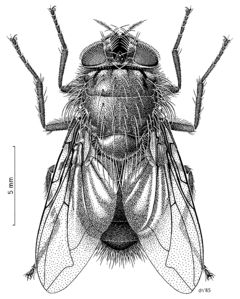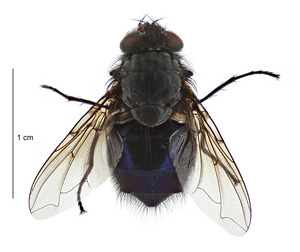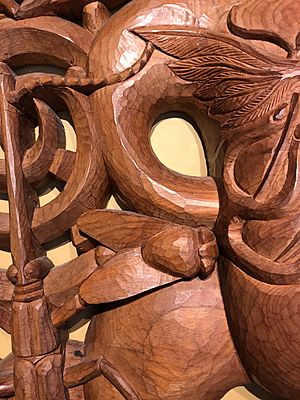Calliphora quadrimaculata facts for kids
Quick facts for kids Calliphora quadrimaculata |
|
|---|---|
 |
|
| Female Calliphora quadrimaculata illustration by Des Helmore | |
| Scientific classification | |
| Kingdom: | |
| Phylum: | |
| Class: | |
| Order: | |
| Family: | |
| Genus: |
Calliphora
|
| Species: |
C. quadrimaculata
|
| Binomial name | |
| Calliphora quadrimaculata (Swederus, 1787)
|
|
The Calliphora quadrimaculata, often called the New Zealand blue blowfly, is a common insect. Its Māori name is rango pango. This fly belongs to the Calliphora genus, which is part of the Calliphoridae family. These flies are found all over New Zealand. They also live on nearby islands like Chatham, Auckland, Stewart, and Campbell Islands.
Most blowfly larvae (maggots) in New Zealand need to eat animal tissue or waste to grow. But the New Zealand blue blowfly is special. Its larvae can grow up by eating decaying leaves of snow tussock plants. This happens in mountain areas. They can become adult flies without ever eating animal tissue.
Contents
What Do Blue Blowflies Look Like?
Young Blue Blowflies (Larvae)
Young blue blowflies, called larvae or maggots, have a head and body. Their body has three parts for the chest area and eight parts for the belly. The head is very small. It often hides inside the first chest part. On their head, they have tiny feelers called antennae. They also have mouthparts with small, stiff hairs. These hairs help them sense things.
Their mouth is at the front of the head. It has two hard, hook-like parts. The first chest part has two small holes called spiracles. These are for breathing. The body parts are separated by narrow spines. These spines are very large on C. quadrimaculata larvae. This helps scientists tell them apart from other species.
Adult Blue Blowflies
The adult New Zealand blue blowfly is the biggest native blowfly in New Zealand. It can be about 9.5 to 15 millimeters long. That's about the length of your fingernail to a little over half an inch! Like all insects, it has a head, a middle body part called a thorax, and a back part called an abdomen. It also has one pair of wings.
Male flies have eyes that meet in the middle of their head. Female flies have eyes that are separated. Both male and female flies have very hairy eyes. The thorax, or middle body part, is mostly black. But the lower back part of the thorax is brownish. The top middle plates of the thorax are covered in grey dust. The bases of their wings are dark brown, and the wing veins are brown. They have six legs. The upper part of their legs is blackish-brown with a thin grey dust. The lower leg parts are reddish-brown. The abdomen, or back part, is black. It has shiny reflections that look metallic violet or blue-green.
Where Do They Live?
The New Zealand blue blowfly is endemic to New Zealand. This means it is only found naturally in New Zealand. You can find it all over the main islands. It also lives on Chatham, Auckland, Stewart, and Campbell Islands. Flies found on Auckland and Campbell Islands look a little different. Their abdomen is blue-green metallic instead of violet metallic.
Where They Like to Be
These flies can live almost anywhere in New Zealand. But they really like mountain areas. They especially like places where snow tussock plants grow. This is common in the South Island mountains and on Stewart Island.
You might also find them near farms. They can sometimes be involved in a problem called fly strike in sheep. This is when fly maggots live on sheep. The New Zealand blue blowfly doesn't usually start this problem. But it can join in if other flies have already started it. These flies are rarely found inside houses.
Life Cycle of the Blue Blowfly
New Zealand blowflies have a quick life cycle. A female fly lays her eggs. For C. quadrimaculata, she can lay them on decaying plants, not just dead animals.
- Eggs: After about 24 hours, the eggs hatch into larvae.
- Larvae (Maggots): The larvae grow through three stages. During this time, they eat either plant or animal tissue.
- Pupae: After about eight days, the larva stops eating. It then moves to a dry spot, often a few centimeters under the soil. There, it changes into a pupa.
- Adults: About two weeks later, an adult fly comes out of the pupa. It is ready to mate.
Female blowflies live for about two to three weeks. In that short time, they can lay around 600 to 800 eggs. The whole cycle, from egg to adult fly, takes about 20 to 25 days. New Zealand blue blowflies mostly mate during the summer months, especially in February. This is because they need warmer temperatures for their eggs to grow into adults.
What Do They Eat?
New Zealand blue blowflies mostly eat decaying dead animals and decaying plant material. They are also known to help pollinate some types of Hebe flowers in mountain areas. So, they might also drink nectar from these flowers.
Who Are Their Enemies?
C. quadrimaculata flies have many predators. These include fish, spiders, frogs, other bigger insects, and birds. Scientists have not found much evidence of parasites or diseases that affect these specific blowflies.
However, blowflies can sometimes spread germs. They can carry bacteria that cause infections from animals to humans. For example, they can spread germs that cause conditions like dysentery. There is also a condition called myiasis. This is when blowfly maggots live in the tissue of animals. While C. quadrimaculata is not usually the main cause of myiasis, it can sometimes be involved as a secondary source.



